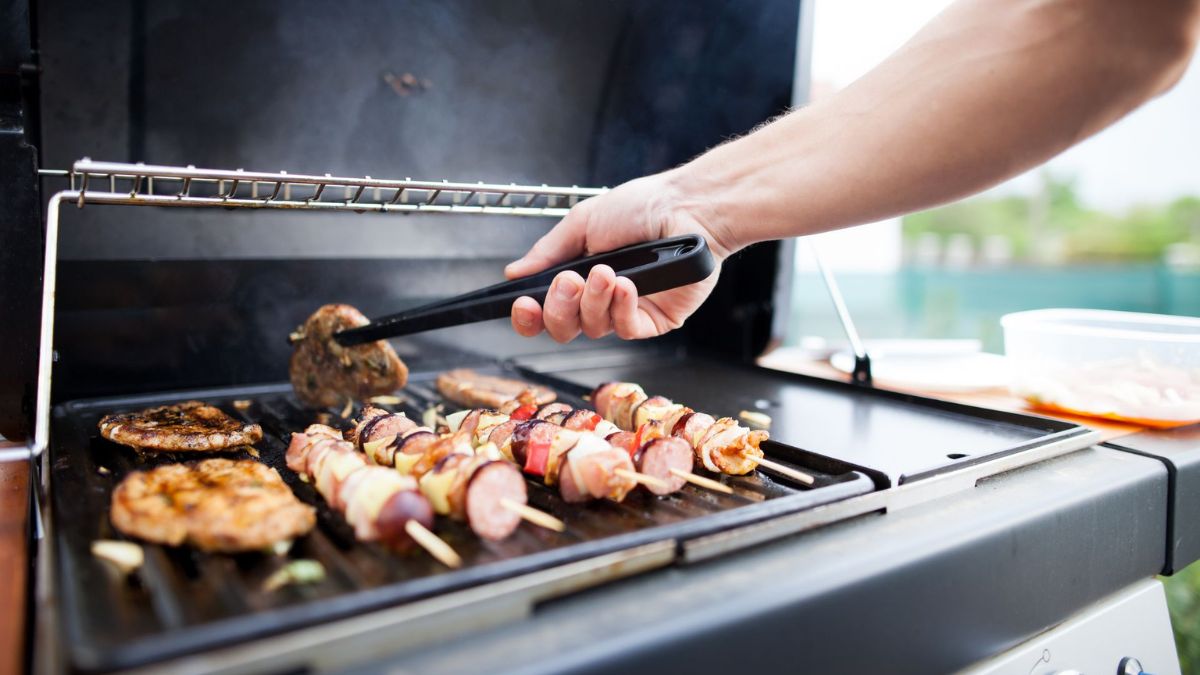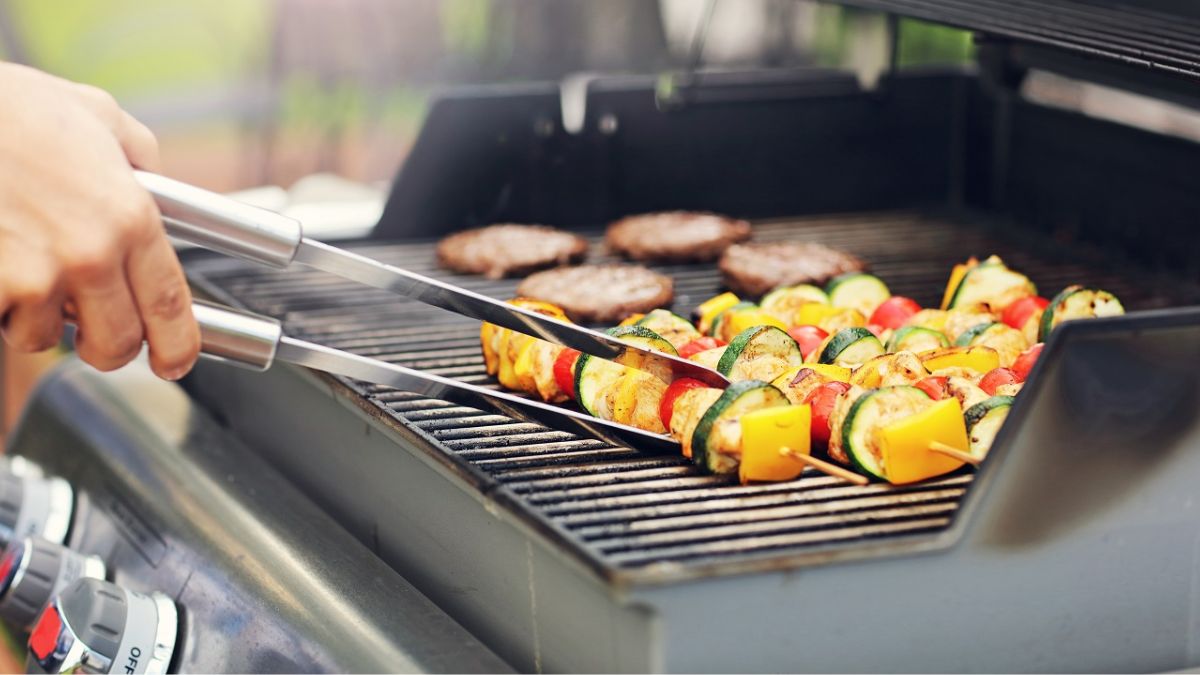A gas grill is just a grill that uses gas to cook food. Most gas grills use liquid propane gas from a tank connected to the grill. However, some grills can be hooked up to the same fuel tank as your stove or oven to a gas line that runs to your house.
Gas grills are outdoor cooking appliances fueled by propane or natural gas. Most come with a lidded cook box mounted in a wheeled cart for portability. Metal burners beneath the cooking surface emit small flames, radiating heat upward toward the food. Natural-gas models are connected to household gas supplies, and propane models draw fuel from portable tanks attached to the burners with a hose and regulator.
How to Use a Gas Grill?
1. How to Start a Gas Grill
Many people prefer cooking on a gas grill because it’s easier to start than a charcoal grill. However, there are steps to follow.
Here’s how to start a gas grill:
- Always start by opening the lid so the cooking chamber doesn’t fill up with gas.
- If you use a grill that runs on liquid propane, turn the knob on the top of the tank counterclockwise until it stops, which will open the valve all the way.
- If your grill has an igniter button, turn the first burner knob up and push the button.
- If your grill has no ignition button, you can light the first burner with a long fireplace match or a lighter wand.
- Once the first burner is on, turn up the heat on the other burners.
- Close the lid and wait 10 to 15 minutes for the temperature to rise.
2. Cooking on a Gas Grill
After preheating the grill, you’re almost ready to start cooking.
Use a grill brush, a wooden grill scraper, or a wad of aluminum foil to clean the hot cooking surface. This will get rid of any leftover food from the last cookout. Before putting food on the hot grilling grate, wet a paper towel with vegetable oil and slide it along the grate with tongs to make it less likely to stick. Spread your food out on the grill. Don’t crowd the cooking surface, so you have room to flip and turn your food. Extra space will also let you move things around if you need to for even cooking.
You can use direct or indirect heat for cooking on a gas grill. When using direct heat, the fire is right under the food. It browns the food outside, giving it more flavor and texture while cooking it to the center. Use direct heat for small, tender pieces that can be cooked in less than 20 minutes, like:
- Hamburgers
- Steaks
- Chops
- Boneless chicken pieces
- Fish fillets
- Sliced vegetables
A grill for indirect heat has heat on both sides or off to one side. The food is put on the part of the cooking grates that aren’t lit. Use the indirect method to grill big pieces of meat that need 20 minutes or more, or foods that are so delicate that direct heat would dry them out or burn them, like:
- Roasts
- Bone-in poultry pieces
- Whole fish and delicate fish fillets
- Whole chickens
- Ribs
You can also finish thicker foods or cuts with bones that have been seared or browned over direct heat with indirect heat. Don’t be tempted to open the lid often when cooking on a gas grill, no matter what temperature you use. When you peek inside, smoke and hot air escape, making the food take longer to cook. Please don’t touch the food until it’s time to flip it. Use a spatula or tongs to give it a little push. You can flip the food if it comes off the grill easily. If there is resistance, wait a few minutes for the outside to cook more.
3. How to Turn Off a Gas Grill
A person is cleaning a cooking grate with a wire grill brush.
Take your foot off the grill when it’s done the way you want. Please put it on a platter and cover it with a tent made of aluminum foil. While the food is taking a break:
- Set all of the knobs on the burners to “off.”
- Turn the knob of the valve on the propane tank clockwise until it stops.
- To clean the grilling grate, use the grill brush, a scraper, or aluminum foil.
- Close the grill’s lid and use a grill cover to keep it safe until the next cookout when the grill is completely cool.
What are the Gas Grilling Tips and Techniques?
Someone is taking care of food on a gas grill.
As you use a gas grill more, you will get better at it. Here are some grilling tips to get you started:
- Make sure you have a spare propane tank, so you don’t run out of gas before the food is done.
- For more smoke flavor, soak wood chips in water for half an hour before putting them in a foil pouch or smoker box.
- Use a grilling pan for food that is too small or fragile for the cooking grate.
- Almost always, you should only turn the food once.
- Use dry rubs and marinades to season your food well before putting it on the grill.
- Use an instant-read thermometer to see if your food is done to make sure it has reached a safe temperature inside.
It would help if you used a gas grill before getting good at it. Don’t be afraid to try out new things. Have everything you need ready, so you don’t have to run back and forth between the kitchen and the grill to get things. Always cook on clean grates, preheat on the highest setting, and ensure you have enough gas for your cookout. Make sure you know how to turn off a gas grill for safety. When you need a gas grill and parts for it, we’ll bring them to you.
What is the Right Cooking Temperature?
We’ve already gone over how to use the hand test to determine how hot your grill is. But what temperature is best? What you’re cooking makes a difference.
- High heat (above 450°F) is best for foods that cook quickly, like kebabs and shrimp, as well as steaks and pork chops that taste better when the outside is seared.
- Medium heat (350 to 425°F) is better for burgers, chicken with bones, and most vegetables because it lets the insides cook all the way through before the outsides burn.
- Medium-low heat (325°F) is best for cooking sausages, pork tenderloin, and baked potatoes, which need to be cooked slowly.
- Tough cuts like brisket, ribs, and pork shoulder need low heat (below 300°F).
What should you Look for When Buying a Gas Grill?
A lot of people have gas grills. Below is my top choice, but first, here are some shopping tips if you want to do your shopping around. Here are some things to look for in a gas grill.
Construction:
Make sure the grill is made of strong metal. Stainless steel is strong and looks good, but it doesn’t keep heat as well as cast aluminum and is harder to keep looking nice than porcelain enamel on steel. Don’t buy a grill with sharp edges or spaces between the edges.
Burners:
The more burners you have, the more hungry people you can feed at the same time. More burners also give you more options. For example, if you’re simultaneously cooking steaks and chicken on the grill, you can cook each on a different heat setting. Look for burners made of stainless steel or bronze, which will last longer than cast iron and won’t rust.
Wheels:
If a grill has at least two wheels, it’s easy to move it around on the patio or put it away when the season is over.
A Removable Grease Tray:
Every time you have a cookout, you want to be able to get rid of any grease that fell. Many use aluminum pans that can be thrown away and replaced.
Little Extras:
Any little bit of extra money will be nice to have. For example, you can put your spatula or a tray of burgers on a side table. If you have a side burner, keep a pot of barbecue sauce or baked beans. You can hang your tongs, a brush, or a bottle opener on a tool hook. Even though built-in thermometers and fuel gauges are not very accurate, they give you a general idea of how hot it is under the lid and how much gas is left in the tank.
What are the Types of Gas Grills?
Tabletop Grills:
These small models are great for one person or two. Because they are small, they are great for camping, tailgating, and grilling on the beach.
Portable Cart Grills:
Most gas grills are built on wheeled carts that can be moved around. Which model you choose depends on how much you cook, what features you want, and how much money you have. Most grills have between two and six burners, often used to describe their size. Higher-end stainless steel grills often have extras like rotisserie burners that use infrared light to sear meat.
Fixed Grill:
Fixed grills can be a good choice for serious grillers who set up permanent outdoor cooking stations in their backyards. Like tabletop grills, they don’t have legs or wheels, and they’re usually bigger than grills with carts, so they can fit in built-in outdoor kitchens.
Flat-Top Grill, a.k.a. Griddle:
When gas grills first came on the market, flat-top grills were almost unheard of. Because these grills heat a flat, continuous metal cooking surface instead of a slatted grate, they cook more evenly and are easier to sear and clean.
Plus, you can cook pancakes, eggs, and many other things you can’t do on a regular gas grill.
How Much do Gas Grills Cost?
Gas grills that are portable and can cook for one or two people cost between $100 and $300. Small units with two burners and wheels can cost anywhere from $300 to $600, depending on the brand, features, and materials. Depending on their fancy, full-size grills with four or six burners can cost $1,000, $1,500, or even more.
Expect to pay a lot for units with extra features like infrared searing elements, side tables with burners for pots and pans, and built-in electronic thermometers that can connect to a smartphone.
Conclusion
Gas grills cook food quickly and are easy to use, even if you have never used a grill. Models that run on propane are easy to move and can be used anywhere. All gas grills heat up quickly and are ready to cook in about 10 to 15 minutes after being lit.
Grease and soot build up on all grills, but gas grills are easier to clean than charcoal grills, heat more evenly, and are easier to control. Charcoal grills cost less to buy and run than gas grills. They also don’t make food taste as rich and smoky as charcoal grills.


